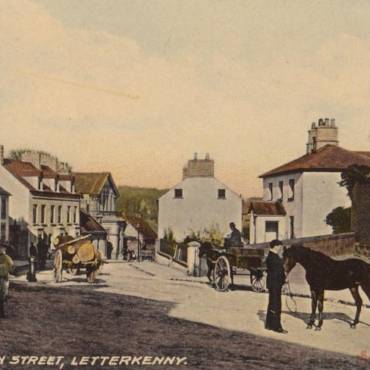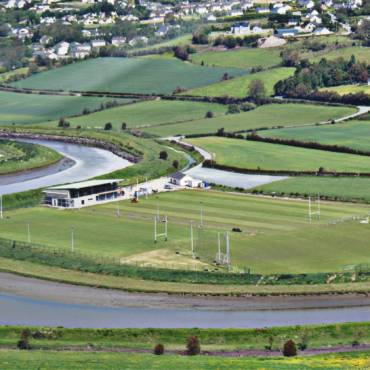THE US CIVIL WAR & THE MAN FROM GLENSWILLY
Thursday 21st July 2016 marks the 155th anniversary of the First Battle of Bull Run, the first major engagement in the American Civil War. In an open plain near the Potamac River in Virginia on July 21st 1861, the Union Forces of Abraham Lincoln came face to face with the Confederate Army under the command of ‘Stonewall’ Jackson. A little known fact about that decisive battle though is that one of the first casualties was a Captain James Haggerty, who originally hailed from Glenswilly in County Donegal. He was, of course, not the only Donegal man to fight in the war. Michael Dougherty from Falcarragh, John Patton from Ramelton and Stephen Joseph McGroarty from Mountcharles are just three of the many Donegal men, not to mention Irishmen, who enlisted and took part in the bloody and grueling conflict. However, the story of James Haggerty’s life and the esteem in which he was once held seem to have been largely forgotten over time in his native Glenswilly and his exploits deserve to be remembered and appreciated today.
James Haggerty (most likely originally Hegarty but altered at Ellis Island) was born two hundred years ago, in 1816, in Glenswilly. In his teens he was an apprentice carpenter, but due to the immense poverty of the time in the area, he went to Scotland in 1844. By 1849 though, Haggerty and his brother Bryan decided, like so many other Irishmen at the time, to emigrate to the United States.
They first landed in New York, before living for a short time in Philadelphia. Returning to New York, in July 1856 Haggerty opened his own business as a house carpenter and builder, located at Bleeker Street between Broadway and Crosby Street.
Gathering together in the big cities at the time, the Irish emigrants often struggled to adjust to their new environment. As a result, local militia companies offered them a chance to get involved in social and political activities, offering possible advancements in the local society. The 69th Regiment of the New York State Militia was formed on October 12th 1851, primarily as a means of training Irishmen to one day return home and fight for Irish freedom. Haggerty became involved around 1853 with the 75th Regiment, known as the “Wolfe Tone Volunteers,” and quickly became Captain. Haggerty’s company was attached to the “Republican Rifles” under Colonel Thomas Francis Meagher, the famed 1848 Young Ireland Rebel and designer of the Tricolour Irish Flag. The two men became good friends and they held each other in the highest regard. When the “Rifles” became a State Militia unit (75th Rifles), Haggerty was promoted to Lieutenant Colonel.
On the elevation of Colonel Michael Corcoran, a native of Carrowkeel, Co. Sligo, to the command of the 69th Regiment, Lieutenant Colonel Haggerty became Captain to his former company, with the troop earning the nickname, “Haggerty’s Bullies.”
Then, in early 1861, as the Confederates fired on Fort Sumter, the Civil War began. President Abraham Lincoln issued a call to arms on April 15th 1861 for 75,000 volunteers. On April 20th, the 69th Regiment was detailed for immediate service at Washington, D.C., to join other Union forces. On April 23rd 1861, amid “deafening cheers” the 69th Regiment, 1040 strong marched down Broadway and into history.
Bull Run is a 32 mile long tributary of the Potamac River in Virginia. At 11:00 am, on the morning of July 21st 1861, the 69th Regiment, with Haggerty at its head, splashed across the river and upon reaching the crest of the hill, they engaged with the Confederate army in the first major battle of the American Civil War – the First Battle of Bull Run.
In the sporadic and unorganised mêlée that followed, while leading a brave charge against the troops of Stonewall Jackson, Captain James Haggerty made a dash to cut off a runaway Confederate soldier, who immediately turned, raised his gun, and fired point blank at Haggerty, who fell to the ground from his horse and died. Union soldiers soon cut down the gunman in a hail of bullets.
Thomas Francis Meagher, along with four Sergeants, took Haggerty’s body to a farm house nearby, placed his sword crosswise on his chest, and left him there. His body was subsequently carried on a farmhouse door to Cub Run, some four miles from the field of battle, where he was temporarily buried and a mattress thrown over the grave along with other soldiers. The Battle of Bull Run ended in a Confederate victory with the Union forces retreating amidst heavy losses.
The following year, at a meeting of the Board of Officers of the 69th Regiment in New York, on April 3rd 1862, Captain Theodore Kelly and Lieutenants James M. Canton and John Fahy were chosen to return to the battlefield and bring back the remains of Haggerty.
They set out on April 7th, reaching Washington early the next day. They traveled throughout the day and night, reaching Virginia and then continuing on immediately to Cub Run. Upon reaching the site of the temporary burial, they shoveled off the snow, and after three or four hours, struck the mattress that had been thrown over the grave. They continued to dig, and finally hit the door on which Haggerty was carried from the field.
They constructed a simple coffin and carried it back to Virginia, over streams and swamps, and then to Washington, from where the body was returned to New York by train. On April 14th Haggerty’s remains were visited by thousands of people with his burial taking place at Calvary Cemetery in Queens following a large funeral.
The esteem in which Haggerty was held at the time is noted by the strenuous efforts of the 69th Regiment to retrieve the remains of their fallen officer and by the large attendance at his wake and funeral. In particular, Thomas Francis Meagher, the famed Irish Nationalist, had this to say about Captain James Haggerty from Glenswilly:
“On the silent fields which these noble mountains overlook and those deep groves shadow, I see many a strong and gallant soldier of the 69th whom I knew and loved: and they lie there in the rich sunshine discolored and cold in death. All of them were from Ireland, and as the tide of life rushed out, the last thought that left their hearts was for the liberty of Ireland. Prominent amongst them, strikingly noticeable by reason of his large iron frame, and the boldly chiselled features on which the impress of great strength of will and intellect was softened by a constant play of humor and the goodness and grand simplicity of his heart – wrapped in his rough old overcoat, with his sword crossed upon his breast, his brow boldly uplifted as though he were still in command, and the consciousness of having done his duty sternly to the last animating the Roman face – there lies James Haggerty – a braver soldier than whom the land of Sarsfield and Shields has not produced, and whose name, worked in gold upon the colors of the 69th, should be henceforth guarded with all the jealousy and pride which inspires a regiment, wherever its honor is at stake and its standards are in peril.”
Captain James Haggerty left behind a widow and a two year old daughter. His brother Bryan served as a Sergeant in the 69th New York Volunteer Infantry, and was mortally wounded on July 1st 1862. Two sisters, who had also left their homeland, Mrs. Toner and Mrs. Rose Hunter, were in attendance at his funeral.
For many years, Haggerty lay in an unmarked grave in New York “unsung, unhonored, neglected and except for mention in Civil War history books – forgotten.” To rectify this, in 1992, the Donegal Association of New York decided to erect a memorial in his honour at the First Calvary Cemetery. Sadly, no such memorial exists (as yet) in his native Glenswilly.



